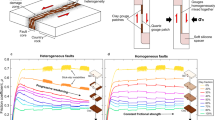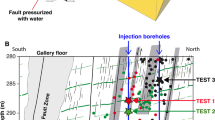Abstract
INCREASING evidence that the San Andreas fault has low shear strength1 has fuelled considerable discussion regarding the role of fluid pressure in controlling fault strength. Byerlee2,3 and Rice4 have shown how fluid pressure gradients within a fault zone can produce a fault with low strength while avoiding hydraulic fracture of the surrounding rock due to excessive fluid pressure. It may not be widely realised, however, that the same analysis2–4 shows that even in the absence of fluids, the presence of a relatively soft 'gouge' layer surrounded by harder country rock can also reduce the effective shear strength of the fault. As shown most recently by Byerlee and Savage5, as the shear stress across a fault increases, the stress state within the fault zone evolves to a limiting condition in which the maximum shear stress within the fault zone is parallel to the fault, which then slips with a lower apparent coefficient of friction than the same material unconstrained by the fault. Here we confirm the importance of fault geometry in determining the apparent weakness of fault zones, by showing that the apparent friction on a sawcut granite surface can be predicted from the friction measured in intact rock, given only the geometrical constraints introduced by the fault surfaces. This link between the sliding friction of faults and the internal friction of intact rock suggests a new approach to understanding the microphysical processes that underlie friction in brittle materials.
This is a preview of subscription content, access via your institution
Access options
Subscribe to this journal
Receive 51 print issues and online access
$199.00 per year
only $3.90 per issue
Buy this article
- Purchase on Springer Link
- Instant access to full article PDF
Prices may be subject to local taxes which are calculated during checkout
Similar content being viewed by others
References
Hickman, S. H. Rev. Geophys IUGG Rep. 759–775 (1991).
Byerlee, J. Geophys. Res. Lett. 17, 2109–2112 (1990).
Byerlee, J. D. Tectonophysics 211, 295–303 (1992).
Rice, J. R. in Fault Mechanics and Transport Properties of Rocks (eds Evans, B. & Wong, T.-f.) 475–503 (Academic, London, 1992).
Byerlee, J. D. & Savage, J. C. Geophys. Res. Lett. 19, 2341–2344 (1992).
Hansen, B. in Pro. 5th int. Conf. Soil Mech. Found. Engng 127–131 (Dunod, Paris, 1961).
Mandl, G., de Jong, L. N. J. & Maltha, A. Rock Mechanics 9, 95–166 (1977).
Logan, J. M., Friedman, M., Higgs, N., Dengo, C. & Shimamoto, T. U.S. geol. Surv. Open File Rep. 79-1239, 305–343 (1979).
Moore, D. E., Summers, R. & Byerlee, J. D. J. struct. Geol. 11, 329–342 (1989).
Moore, D. E. & Byerlee, J. D. Tectonophysics 211, 305–316 (1992).
Saada, A. S., Fries, G. & Ker, C.-C. Soils Found. 23, 98–112 (1983).
Byerlee, J. D. Pure appl. Geophys. 116, 615–626 (1978).
Byerlee, J. D. J. geophys. Res. 72, 3639–3648 (1967).
Summers, R. & Byerlee, J. U.S. geol. Surv. Open File Rep. 77–142, 129 (1977).
Dunn, D. E., LaFountain, L. & Jackson, R. J. geophys. Res. 78, 2403–2417 (1973).
Marone, C., Raleigh, C. B. & Scholz, C. H. J. geophys. Res. 95, 7007–7025 (1990).
Lockner, D. A., Moore, D. E. & Reches, Z. in 33rd U.S. Rock Mechanics Symp. (eds Tillerson, J. R. & Wawersik, W. R.) 807–816 (Balkema, Rotterdam, 1992).
Byerlee, J. D. J. geophys. Res. 73, 4741–4750 (1968).
Ismail, I. A. H. & Murrell, S. A. F. Tectonophysics 175, 237–248 (1990).
Beeler, N. M., Weeks, J. D. & Tullis, T. E. Eos 73, 511 (1992).
Rice, J. R. & Ruina, A. L. J. appl. Mech. 50, 343–349 (1983).
Author information
Authors and Affiliations
Rights and permissions
About this article
Cite this article
Lockner, D., Byerlee, J. How geometrical constraints contribute to the weakness of mature faults. Nature 363, 250–252 (1993). https://doi.org/10.1038/363250a0
Received:
Accepted:
Issue Date:
DOI: https://doi.org/10.1038/363250a0
This article is cited by
-
Evolution of Wear and Friction Along Experimental Faults
Pure and Applied Geophysics (2014)
-
Slip on 'weak' faults by the rotation of regional stress in the fracture damage zone
Nature (2006)
-
An earthquake instability model based on faults containing high fluid-pressure compartments
Pure and Applied Geophysics PAGEOPH (1995)
-
Implications of Coulomb plasticity for the velocity dependence of experimental faults
Pure and Applied Geophysics PAGEOPH (1995)
-
Triaxial testing of Lopez Fault gouge at 150 MPa mean effective stress
Pure and Applied Geophysics PAGEOPH (1994)
Comments
By submitting a comment you agree to abide by our Terms and Community Guidelines. If you find something abusive or that does not comply with our terms or guidelines please flag it as inappropriate.



